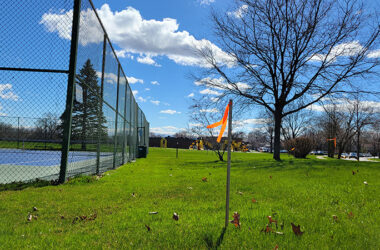Wild parsnip (Pastinaca sativa) is a highly toxic weed that is spreading rapidly through Illinois and has now been spotted in Homewood. Local gardener Kate Duff offers advice about identifying and safely removing the plant.
in the 18000 block of
Homewood Avenue in
Homewood. (Photos by
Eric Crump/H-F Chronicle)
Wild parsnip (Pastinaca sativa) is a highly toxic weed that is spreading rapidly through Illinois and has now been spotted in Homewood.
Because it looks like a wildflower, you may be tempted to leave it in your garden or use it as a cut flower. But the plant is dangerous to both people and animals because of its ability to cause serious skin damage.
The oils in the stalk contain a chemical called psoralen which reacts with the skin in the presence of sunlight, causing a chemical burn. People who are exposed develop an itchy, painful, blistering rash. The rash is slow to heal and may result in dark scars that can last for months or years.
Wild parsnip is related to Queen Anne’s Lace, parsley and carrots. Like those species, it is a leafy, branching plant with hundreds of tiny flowers organized in umbrella-shaped clusters called umbels at the top of each stem.
parsnip has distinctive
ridges.
To distinguish wild parsnip from similar plants, look first at the stalk: it has vertical grooves that are characteristic of this plant. The leaves are long with two rows of ragged-edged leaflets on either side of a central stalk, and the flowers are yellow. The plant itself can grow up to 5 feet tall.
part of the wild parsnip
is the sap from the stalk.
Horticulturalists are unclear why wild parsnip has been spreading more rapidly in recent years. Some scientists suspect climate change is a contributing factor.
fights back Monday
against an incursion of
wild parsnip in an alley
a block north of Ridge
Road in Homewood.
By removing the plant promptly and safely from your property, you will help check its spread through the H-F area.
a wild parsnip to show how
tall the plant can grow.
The homemade hazmat
outfit she is wearing was
mainly for dramatic effect,
she said, but gloves and
caution when handling the
toxic plant are highly
recommended.
To remove wild parsnip safely, follow these steps:
- Cover skin with long pants, sleeves, rubber gloves and closed shoes. You may also want to use safety glasses to prevent eye contact and a dust mask to prevent inhalation.
- Cut the plant at the soil line with pruners and dig out the root. Keep the stalk as intact as possible to avoid releasing the oils. Do not use weed wackers as they can cause the sap to spray.
- Securely bag the plant remains and dispose of in household waste containers, not yard waste containers or your composter. Never burn the plant remains, because this can release the oils into the air.
- If any sap gets on the skin, cover the area immediately until you get inside, then wash with soap and warm water or rubbing alcohol, and cover the skin again for at least 8 hours to prevent sun exposure. If a rash appears, contact your doctor.

